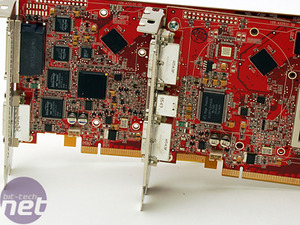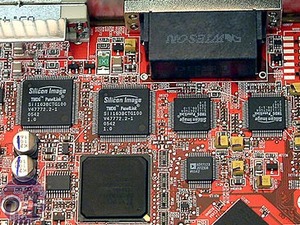How ATI's CrossFire Technology works:
CrossFire was initially launched back in June 2005, and it took ATI about the same time as NVIDIA to get the technology out of the lab. In fact, we didn't get our hands on hardware until the end of September. This was in the form of a pair of Radeon X850 XT video cards and a CrossFire Xpress 200 motherboard. Since then, ATI has renamed CrossFire Xpress 200 to CrossFire Xpress 1600, for marketing purposes. In March this year, the company announced its CrossFire Xpress 3200 chipset, which came with a pair of true dual PCI-Express x16 interconnects and a number of other improvements to its core logic, too.Obviously, the end of September was very close to the launch of ATI's Radeon X1000-series, which happened on October 5th. As a result of this and a number of massive shortcomings, very few Radeon X850-series CrossFire systems were sold. However, ATI didn't sit still and the company had improved its CrossFire architecture and drivers by the time Radeon X1000-series came around. This included fixing the inability to render games at resolutions above 1600x1200 at 60Hz.
The Hardware:
CrossFire is a strange and confusing technology for anyone who doesn't follow the progress of 3D graphics on a daily basis. This is mainly down to the confusing way that ATI gets CrossFire to work on a pair of ATI video cards. Rather than having one simple method of enabling CrossFire across its entire product stack, ATI came up with a bit of a hack job in all honesty - it's certainly not something that a novice would want to try and get their head round without some help. Let us explain, and we're sure that you'll agree with us.If you're buying high-end Radeon X1900XT or Radeon X1900XTX video cards with the vision of running CrossFire, you need to be sure that you've purchased one CrossFire-ready Radeon X1900 (either X1900XT or X1900XTX) and a Radeon X1900 CrossFire Edition video card. The CrossFire Edition card will come with all of the required hardware for connecting the two cards together to work in CrossFire.


In one way, this is reasonably straight forward if you consider that all CrossFire-enabled motherboard and GPU boxes come with a simple diagram detailing 'what you need to get CrossFired up'. In order to run CrossFire, you need a CrossFire-ready motherboard, a CrossFire Edition video card and a CrossFire-ready video card. At least the box tells you exactly what you need in order to run CrossFire.
Here is where the fun starts, though.
Things change dramatically at the low end of the spectrum. In fact, things change right the way up to ATI's Radeon X1900GT - there are two ways to enable CrossFire on the Radeon X1900GT. Well, there will be soon. Firstly, you can use the method that we've outlined above - this means buying a Radeon X1900GT CrossFire-ready video card and then spending a lot more on a Radeon X1900 CrossFire Edition. Typically, the Radeon X1900GT costs around £200, while a Radeon X1900 CrossFire Edition will set you back around £290-300.
The second method of enabling CrossFire with Radeon X1900GT is in the same way that Radeon X1800GTO CrossFire is enabled. By this we mean that it will be possible to install a pair of Radeon X1900GT's and run a 'masterless' CrossFire configuration, with all data transferring over the PCI-Express bus. Unfortunately, this is not officially supported yet, but it will be possible in a future driver release, scheduled for August this year.
At the low end of the spectrum - anything below and including Radeon X1600XT - ATI enabled support for 'masterless' CrossFire configurations soon after the announcement of Radeon X1000-series on October 5th. However, if you have a video card that is not a part of ATI's X1000-series (i.e. a Radeon X700), you will not be able to enable CrossFire at all. Indeed, with the exception of Radeon X850, there is no support for CrossFire outside of ATI's Radeon X1000-series of products.

MSI MPG Velox 100R Chassis Review
October 14 2021 | 15:04







Want to comment? Please log in.